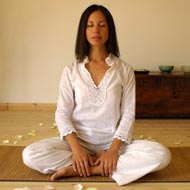- Aromatherapy (36)
- Benefits of Yoga (282)
- Home Remedies (1087)
- massage therapy (9)
- Preventive Therapy (135)
- Running (41)
- Skin Care (15)
- Stress Relief (25)
- Stretching (5)
- walking (33)
- Womens Health (14)
- Yoga Benefits for Pregnant Women (16)
- Yoga Benefits for Students (3)
- Yoga for Children (11)
- Yoga for Holistic Living (37)
- Yoga for Midlife Crisis (3)
- Yoga for Senior Citizens (2)
- Yoga for the Workplace (1)
- Yoga Health Tips (185)
- Yoga Practice during Menstruation (5)
Yoga Breathing Techniques

Yoga breathing or Pranayama, which can be translated as the science of breath control or breath exercises is one of the five principles propounded in the practice of yoga. Breathing is life. Breath is equivalent to Prana or our vital energy. When we breathe, we take in oxygen, which passes to the blood and from there to all parts of the body, thus helping them to function optimally. Oxygen also helps to draw out all the toxins in the blood and flush them away.
Yoga propagates proper breathing techniques, which will ensure that the body gets the optimum quantities of vital energy, while performing the various poses. Observing proper breathing techniques while performing the poses, also inculcates self-discipline and self-purification. That is why it is important to control your breath while performing yoga. Practicing yoga breathing will ensure that you have proper breath control while doing yoga.
An important step is to learn to relax. You must keep in mind that when we become tense, all the muscles in our chest, neck and arms tend to contract. This also means that the thoracic muscles too, also contract and thus restrict the amount of air that is inhaled. Our breath then becomes shallow and short. This leads to less oxygen in our blood, a drop in circulation and thus less oxygen available for cleansing the system.
Another important point to note for breathing correctly is that you should breathe through your nose and not through your mouth. The nose has fine hairs which trap dust and pollutant particles as well as germs and bacteria. It also warms the inhaled air before it enters the lungs.
Breathing should be steady, smooth and continuous, and not irregular or jerky. Concentrate on the exercise that you are performing. Do not repeat the exercises too often and do not do them mechanically. Your exercises should be gentle and you should not do them in a hurry. There should be some change and variety in your exercises. Do not do your breathing exercises when you are on the point of exhaustion or weariness.
Since it is important that your breath should be smooth when you are practicing Pranayama, stop immediately if you find that it has become unsteady or rough. Relax for a while and let your breathing come back to normal before continuing again.
During Pranayama, you take in air via the nose, then you hold it in your lungs for some time, before exhaling it through the mouth. Gradually you will learn to breathe deeper, and hold your breath in for longer periods. This will slowly strengthen the muscles of your abdomen and the diaphragm, helping you have better breath control.
- RSS Feeds -
- All posts
- All comments
- Yoga Techniques Yoga, that age-old science – and art – of keeping healthy and fit...
- Breathing Tips For Exercises Breathing is a natural and spontaneous process, we do breathe every moment as...
- Buddhist Meditation Meditation means training the mind, and it is present in some form or the oth...
- Importance Of Yoga And Meditation What is meditation? Meditation is a practice that has been associated with al...